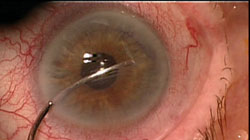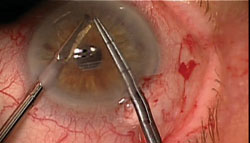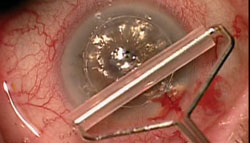Modified DSEK technique promotes graft fixation, prevents complications
A modified Descemet’s stripping endothelial keratoplasty technique minimizes common risk factors such as graft dislocation and pupillary block. In addition, this approach allows surgeons to leave the air bubble in place after surgery.
Pupillary block may increase IOP, causing glaucomatous nerve damage and iris sphincter damage, according to OSN Cataract Surgery Board Member Elizabeth A. Davis, MD, FACS. This technique allows surgeons to circumvent those risk factors, she said.
“Since using this approach, I have not had a single pupillary block,” Dr. Davis said in an interview with Ocular Surgery News. “My incidence of slipped discs has gone down tremendously.”
The modified procedure normally takes 15 to 20 minutes.
Dr. Davis said her graft dislocation rate has dropped to about 5% with the modified technique, down from about 20% with the conventional method.
John P. Berdahl, MD, said it is easy to adapt to the technique.
“It’s no more difficult than a standard DSEK procedure,” he said. “It may be one more step at the time of surgery, but it prevents you having to let air out of the eye either in the OR or at the slit lamp later on. So I think that technically it’s equivalent, and it’s an easy transition to make.”
There is a short learning curve with the new technique, Randy J. Epstein, MD, said.
“There are no new skills that people need to master except the peripheral iridotomy, which I don’t think anybody’s going to have any problem with,” he said. “It’s an important adjunct to the technique. You should not do the technique without it. Unless you do it, you are risking pupillary block, which everyone would agree is a disastrous complication.”
Different from traditional technique
The modified DSEK technique is similar to the traditional approach but with three additional steps: constricting the pupil, doing an inferior peripheral iridotomy and leaving a 100% air bubble in the anterior chamber postoperatively, Dr. Davis said.
 Figure 1. After the cornea is marked and the pupil is constricted, the endothelium is stripped from the host cornea. |
 Figure 2. An inferior peripheral iridotomy is performed with microscissors and Utrata forceps. |
 Figure 3. The donor lenticule in a 30/70 taco fold is inserted into the anterior chamber through a 3- to 5-mm incision. |
 Figure 4. A 100% air bubble is injected into the anterior chamber. A Lindstrom LASIK flap roller is applied radially from the central apex of the cornea to the periphery in multiple strokes to squeeze out excess interface fluid. Images: Davis EA |
Constricting the pupil prevents the air bubble from moving behind the iris.
“People dilate the pupil because they figure, ‘If air gets behind the iris and if I’ve got a dilated pupil, it can come forward,’” she said. “That’s like saying you don’t want somebody to go into another room, so you open the door. I would want to constrict the pupil to prevent bubble migration posteriorly. … I started constricting the pupil and putting in a full air bubble so I could keep my [donor] disc in place.”
The inferior peripheral iridotomy is barely visible and poses no risk of vision loss, Dr. Davis said.
“It is not an iridectomy. It’s an iridotomy,” she said. “I’m not excising tissue. I lift up the inferior midperipheral iris with Utrata forceps, make a little snip with microforceps and just spread the jaws of the scissors to make certain it’s patent . It is not cosmetically apparent. It’s not an uncontrolled iridectomy that’s enormous and lets in a lot of light. It’s small. It usually sits just behind the graft-host interface anyway.”
Dr. Berdahl said that the inferior peripheral iridotomy safely allows fluid to enter the anterior chamber.
“The inferior [peripheral iridotomy] allows fluid flow to access the anterior chamber without having to go through the pupil, so you avoid pupillary block,” he said.
After inserting a precut donor lenticule in a 30/70 taco fold configuration, Dr. Davis injects a large air bubble into the anterior chamber. The traditional DSEK technique involves releasing the air 8 to 10 minutes after surgery, a time-consuming and risky practice, she said.
“Releasing the air is uncontrolled, so surgeons cannot control how much is released,” she said. “The iris can come to the wound, air can shift posteriorly with the start of pupillary block, or the graft can shift. Then you’ve got to go back and put more air in. All of that manipulation is not good for the health of the endothelium.”
Leaving the air bubble in the anterior chamber saves time and enhances outcomes, Dr. Epstein said.– by Matt Hasson

- John P. Berdahl, MD, can be reached at Minnesota Eye Consultants, 710 E. 24th St., Suite 100, Minneapolis, MN 55404; 612-813-3600; fax: 612-813-3636; e-mail: jpberdahl@mneye.com.
- Elizabeth A. Davis, MD, FACS, can be reached at Minnesota Eye Consultants, 9801 Dupont Ave. South, Bloomington MN 55431; 952-567-6067; fax: 952-885-9942; e-mail: eadavis@mneye.com.
- Randy J. Epstein, MD, can be reached at Chicago Cornea Consultants, 806 Central Ave., Highland Park, IL 60035; 847-432-6010; fax: 847-432-8241; e-mail: repstein@chicagocornea.com.

![]()
DSEK has revolutionized the treatment of endothelial dysfunction, whether it be Fuchs’ dystrophy, pseudophakic bullous keratopathy or any of the other etiologies. Still, the learning curve in DSEK is significant, in spite of the excellent courses available. I have found leaving the anterior chamber fully inflated with air with an elevated IOP decreases the chance of graft dislocation. However, this approach increases the risk of pupillary block, both an annoying and sight-threatening complication.
Dr. Davis’ approach, which includes an inferior peripheral iridectomy, allows leaving the anterior chamber overinflated with air while reducing the risk of pupillary block. I have adopted her approach. The MST microsurgical instruments she teaches work well. Recently, I have utilized a very old technique called iris transfixation. A small amount of viscoelastic is placed under the iris, tenting it forward. A needle such as an Alcon P-7 or Ethicon CIF-4 or a MVR blade is passed under the iris and out through the iris peripherally, creating one or two peripheral iridotomies. I have had no pupillary blocks with this approach with a fully inflated anterior chamber. However it is achieved, an inferior iridectomy or iridotomy is a nice pearl for the surgeon who wishes to retain a large air bubble in the anterior chamber at the end of a DSEK and reduce the risk of pupillary block.
– Richard L. Lindstrom, MD
OSN Chief Medical Editor
